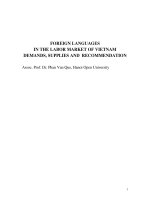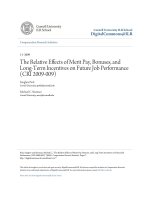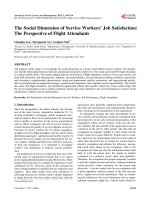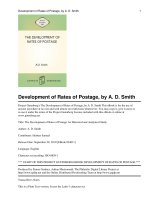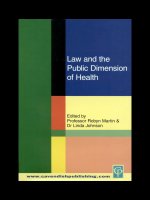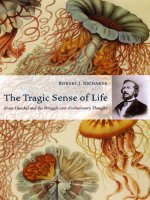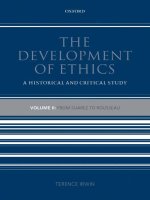The linguistic dimension of kants thought historical and critical essays
Bạn đang xem bản rút gọn của tài liệu. Xem và tải ngay bản đầy đủ của tài liệu tại đây (1.22 MB, 345 trang )
THE LINGUISTIC DIMENSION OF KANT’S THOUGHT
THE LINGUISTIC
DIMENSION OF
KANT’S THOUGHT
Historical and Critical Essays
Edited by Frank Schalow and
Richard Velkley
Northwestern University Press
Evanston, Illinois
Northwestern University Press
www.nupress.northwestern.edu
Copyright © 2014 by Northwestern University Press. Published 2014. All rights
reserved.
Printed in the United States of America
10
9
8
7
6
5
4
3
2
1
Library of Congress Cataloging-in-Publication Data
The linguistic dimension of Kant’s thought : historical and critical essays /
edited by Frank Schalow and Richard Velkley.
pages cm
Includes bibliographical references and index.
ISBN 978- 0- 8101- 2996- 2 (cloth : alk. paper)
1. Kant, Immanuel, 1724–1804. 2. Language and languages—Philosophy.
I. Schalow, Frank, 1956– editor of compilation. II. Velkley, Richard L., editor
of compilation.
B2799.L26L56 2014
193—dc23
2014017250
o The paper used in this publication meets the minimum requirements of the
American National Standard for Information Sciences—Permanence of Paper
for Printed Library Materials, ANSI Z39.48-1992.
Contents
Acknowledgments
vii
Abbreviations and Principal Translations
ix
Preface
xi
Introduction: Situating the Problem of Language in Kant’s Thought
Frank Schalow and Richard Velkley
3
Part 1. The Question of Language
1
The Place of Language: From Kant to Hegel
Robert Wood
29
2
The Language of Time in Kant’s Transcendental Schematism
Frank Schalow
53
3
Language in Kant’s Practical Philosophy
Chris W. Surprenant
70
4
Kant’s Philosophy of Language?
Michael N. Forster
81
Part 2. The Concern for Language in Religion, Politics,
and Aesthetics
5
Jupiter’s Eagle and the Despot’s Hand Mill: Two Views of Metaphor
in Kant
Kirk Pillow
6
Models and “Symbolic Hypotyposis”: Kant on Music and Language
Charles Nussbaum
7
Kant’s Apophaticism of Finitude: A Grammar of Hope for Speaking
Humanly of God
Philip J. Rossi, S.J.
107
134
154
8
Nachschrift eines Freundes: Kant on Language, Friendship, and the
Concept of a People
Susan Shell
174
Part 3. Historical Perspectives on Language
9
10
11
12
Reason, Idealism, and the Category: Kantian Language in Hegel’s
Phenomenology of Spirit
Robert Berman
205
The Language of Natural Silence: Schelling and the Poetic Word
After Kant
Jason M. Wirth
237
Language, Nature, and the Self: Language, Psychology, and the
Feeling of Life in Kant and Dilthey
Eric S. Nelson
263
The Inexhaustibility of Art and the Conditions of Language: Kant and
Heidegger
288
Richard Velkley
Selected Bibliography
311
Contributors
319
Index
321
Acknowledgments
We wish to express our gratitude to the friends and colleagues who have
encouraged us throughout the period of the genesis and publication
of this volume: Ronna Burger, Peter Fenves, Edward Johnson, and Michael E. Zimmerman. In helping to compile the “Selected Bibliography”
for this book, we are indebted to the efforts of Ms. Jade Flynn. For help
in securing funds for the completion of this project, we wish to express
gratitude to Provost Michael Bernstein of Tulane University and the Carl
Muckley Bequest of the Philosophy department at the University of New
Orleans.
Special thanks also go to the senior editor and director of Northwestern University Press, Henry Carrigan and Jane Bunker, respectively,
for lending their time and expertise in bringing this volume to fruition.
Finally, we wish to thank the editors of the following journals for
granting permission to reprint a version of Michael N. Forster, “Kant’s
Philosophy of Language?,”Tijdschrift voor Filosofie 74/3 (2012); Kirk Pillow, “Jupiter’s Eagle and the Despot’s Hand Mill: Two Views of Metaphor
in Kant,” Journal of Aesthetics and Art Criticism 59 (2001): 193–212; Susan
Shell, “Nachschrift eines Freundes: Kant on Language, Friendshp, and the
Concept of a People,” Kantian Review 11/1 (2011): 117–24.
vii
Abbreviations and Principal Translations
The following abbreviations and translations of Kant’s works are cited
throughout the text and notes. Abbreviations used only within a single
chapter are noted on first appearance.
Abbreviations
AA
Akademie Ausgabe, i.e., Kants Gesammelte Schriften (Berlin: de Gruyter,
1902–)
Gr
Grundlegung der Metaphysik der Sitten (AA 4)
KpV
Kritik der praktischen Vernunft (AA 5)
KrV
Kritik der reinen Vernunft (AA 3–4)
KU
Kritik der Urteilskraft (AA 5)
MAM
Mutmasslicher Anfang der Menschengeschichte (AA 8)
MdS
Metaphysik der Sitten (AA 6)
MpVT
Über das Misslingen aller philosophischen Versuche in der Theodicee (AA 8)
Pr
Prolegomena zu einer jeden künftigen Metaphysik (AA 4)
RGV
Religion innerhalb der Grenzen der blossen Vernunft (AA 6)
Translations of Kant’s Works
Cambridge Edition of the Works of Immanuel Kant, general editors Paul Guyer and Allen Wood (Cambridge, Eng.: Cambridge University Press, 1995–)
Critique of Judgment, trans. Werner S. Pluhar (Indianapolis, Ind.: Hackett, 1987)
Critique of Pure Reason, trans. Norman Kemp Smith (New York: St. Martin’s,
1965)
Critique of Pure Reason, trans. Werner S. Pluhar (Indianapolis, Ind.: Hackett, 1996)
Dreams of a Spirit Seer Illustrated by Dreams of Metaphysics, trans. E. F. Goerwitz (New
York: Macmillan, 1900)
ix
x
Ab b r ev i At i ons
Grounding for the Metaphysics of Morals, trans. J. Ellington (Indianapolis, Ind.:
Hackett, 1981)
Kant: Philosophical Correspondence 1759–99, ed. and trans. A. Zweig (Chicago: University of Chicago Press, 1967)
Logic, trans. R. Hartman and W. Schwarz (Indianapolis, Ind.: Bobbs-Merrill,
1974)
Preface
This volume assembles several essays around a common, albeit easily
overlooked topic in Immanuel Kant’s thought: the issue of language and
its importance in shaping the landscape of his critical philosophy. To
be sure, language can be viewed as a formal structure of thought and
expression, as is evident throughout the philosophical tradition. This
collection of essays, however, approaches “Kant’s linguistic dimension”
more broadly as a practice including communication, exchange, and dialogue.
Although there are undoubtedly different avenues to pursue this topic,
a concerted effort has been made to develop a plurality of outlooks that
will allow the reader to achieve a new perspective on the unity of Kant’s
thought as whole, along with its historical influence.
In this regard, Kant’s philosophy is not viewed as a finalized system,
but instead as engendering new possibilities to pursue philosophy and
develop insight into its intimate connection with language. As a result of
the carefully chosen essays in this volume, it is hoped that a new and exciting light will be cast on a thinker whose philosophical work continues
to challenge the scholar and student alike.
xi
THE LINGUISTIC DIMENSION OF KANT’S THOUGHT
Introduction: Situating the
Problem of Language in
Kant’s Thought
Frank Schalow and Richard Velkley
Formulation of the Topic
Among modern philosophers, Immanuel Kant (1724–1804) probably
influenced the development of contemporary philosophy as much as
anyone. Yet, ironically, where the issue of language has become a key
fulcrum of Continental philosophy in the twentieth century, Kant is
rarely viewed as a “pioneer” in this area. Not surprisingly, while there
have been various attempts to address the historical origin and development of the problem of language in Continental philosophy, Immanuel
Kant has been overlooked as a thinker whose breadth of insights have
helped to spearhead this advance. Indeed, an anomaly emerges such
that while Kant’s critical philosophy has been identified as the crossroads
from which subsequent paths of Continental philosophy arise, and while
it is often believed that the concern for language unifies these paths, he is
usually discounted as having either interest in, or insight into, the nature
of language itself.
And yet, for all his apparent indifference to this topic, Kant provides seductive hints concerning the use and nature of language, if only
on the rarest occasions. Most noteworthy, in his work devoted primarily
to art and aesthetics, the Critique of Judgment, he claims that aesthetic experience is possible only because a level of meaning is reserved for the
“communication of sensations,” prior to the use of preset concepts (Critique of Judgment, section 51). This is a representative example of how the
concern for language peers through a shadow of obscurity and indifference. To employ an apt description of a philosopher whom Kant later influenced, Martin Heidegger, language may only “announce itself” rather
than explicitly “show itself” as a “phenomenon.”1 Nevertheless, because
Kant leaves only a trace of the importance of language throughout his
3
4
s c hAl ow
And
v e lk le y
writings, a study devoted to uncovering it and unfolding its implications
can prove to be provocative as well as instructive.
Because the “place” of language in Kant’s thinking is not evident
at the outset, we might consider four different angles from which to approach this problematic. First, the most obvious tactic is simply to consider explicitly what Kant says about language, the actual statements
he makes in the course of his writings, from the “pre-critical” period
through the publication of the three Critiques.2 For example, in section
53 of the Critique of Judgment, Kant describes music as a “language of the
affections,” although, by the same token, he does not extrapolate from
this one statement to consider the nature of language as such. The question that might then be posed is whether Kant had an explicit account or
“theory” of the nature of language (Sprachtheorie). Secondly, regardless
of how explicitly Kant reflected upon language, one might address the
implicit understanding of its importance which arises from the study of
his critical philosophy. In other words, Kant’s multifaceted account of
thinking, judgment, and the limitations of knowledge may harbor certain (implicit) insights about language which can be explicated through
further examination and interpretation of his vast writings. Thirdly, another strategy would be to consider the influences that Kant had on subsequent thinkers who did consider the nature of language. Among these
we must identify two twentieth-century philosophers whose paths intersected in an epic debate in Davos, Switzerland, in 1929:3 (1) Ernst Cassirer (1874–1945), who spearheaded the “back to Kant” movement in
the 1920s and expanded the frontiers of transcendental philosophy to
include a concern for symbol, myth, and culture;4 and (2) Martin Heidegger, who not only provided the most influential alternative to the “neoKantian” interpretation of transcendental philosophy, but also encouraged several of his most accomplished students, including Hans-Georg
Gadamer (1900–2002) and Hannah Arendt (1906–75), to rediscover in
Kant’s thought the inspiration for new philosophical paths. As we will
establish throughout our study, the development of this third approach
requires a more explicit interpretation of Kant’s writings and an appreciation of its continual relevance, as well as its legacy, for the development
of philosophy today. Because twentieth-century methodologies of phenomenology, hermeneutics, and deconstruction all hinge on a common
concern for language, we will underscore the innovativeness of Kant’s
method as implicated in other disciplines that reflect upon the dimension of meaning in human experience, including, history, religion, and
literature, as well as philosophy.
Fourthly, one might propose an “internal critique” of Kant’s own
thought, addressing shortcomings that suggest the need to consider lan-
5
i n t r o d uct i o n
guage as a prerequisite, premise, or presupposition that “grounds” or
even helps to complete his system of critical philosophy. As a case in
point, there has been a perennial question in Kant studies from the time
of his contemporaries—Johann Georg Hamann (1730–88) and Johann
Gottfried Herder (1744–1803) providing the foremost examples 5—as to
whether the transcendental exposition of the principles of knowledge
and morality is self-grounding, or instead hinges on another level of discourse which governs the critical investigation itself apart from the principles it yields. By showing how Kant’s critical enterprise unfolds within
a wider universe of discourse, it might be possible to establish the “architectonic linchpin” which joins the theoretical and practical sides of
Kant’s critical enterprise—a linchpin that has often been conjectured,
albeit not necessarily established, to reside within the purview of the
third Critique. Each of these approaches has merit in its own right. In
the course of study, we will draw upon the interplay of all four, although,
given the need to explicate the “problem of language,” and outline its
larger significance for Kant’s thought, different degrees of emphasis will
be placed on any single approach.
In exploring the place of language in Kant’s philosophy, the first
question to surface is whether the determination of thought as “predication” monopolizes all other forms of expression. Or, conversely, even
where he focuses on the linguistic acts of predication, for example, in
establishing the basis for synthetic a priori judgments about physical objects (i.e., nature), does he presuppose an even more fundamental, “prepredicative” level of “meaning”? Indeed, even within the context of the
Critique of Pure Reason, we can point to certain turning points in the development of Kant’s transcendental methodology that tests the limits of
predication and expression as such. For example, in his famous discussion of “schematism” in the “Analytic” portion of the first Critique, Kant
points to the importance that the “temporal,” “image-producing” power
of imagination (Einbildungskraft) has on reconstructing the “meaning”
of categories on a more original plane. By the same token, in the “Dialectic” Kant extends his transcendental methodology to show how the
“ideas” of reason possess the power to “self-reflexively” convey its own
boundaries, and thereby implement a “tribunal” in which its participants
can “express” disputes and seek their “critical” resolution (Critique of Pure
Reason, A739/B767). As a further illustration, in the Critique of Practical
Reason, Kant leaves open the possibility of the individual’s expression of
his or her own moral self-awareness. And yet, the establishment of the
individual as an instance of a moral lawgiver, and hence as a member of a
community, implies an intermediation between universal and particular,
that is, acts of “judging.” Indeed, the difference between acting out of
6
s c hAl ow
And
v e lk le y
moral discretion, rather than arbitrarily from impulse, lies in being able
to express “why” we act, that is, to articulate the binding character of an
obligation.
Given Kant’s tendency to “presuppose” the importance of language
in his critical philosophy, the second question governing our study is
whether he entered the uncharted waters of the Critique of Judgment in
order to unravel this presupposition. Put another way, does the third
Critique showcase Kant’s attempt to uncover the linguistic roots of his
enterprise—in terms of the evocation of “meaning” and social practice—
and thereby answer the enigma as to the ultimate grounding and systematic unity of his critical philosophy? By interpreting the third Critique in
terms of its wider systematic and methodological role (as well as doctrine
of aesthetics),6 we gain a new perspective from which to reexamine the
premise of Kant’s critical enterprise and identify the form of linguistic
practice that sustains the self-examination of reason in its theoretical and
practical dimensions. In this way, we can discover how the concluding
phase of Kant’s critical philosophy, or the Critique of Judgment, broaches
the topic of language which is otherwise presupposed from the outset of
the Critique of Pure Reason.
The more we unfold the problematic of language, and expand
the scope of these questions, we can consider whether Kant leaves
room for alternative forms of expression. Given the backdrop of a “prepredicative” level of “meaning” on the one hand, and the example of
aesthetic forms of expression on the other, we can discover the extent
to which Kant allows for figurative, metaphoric, and symbolic forms of
language. Conversely, the characterization of language in this multidimensional sense may in turn have direct impact upon diverse fields of
the study of culture, history, and religion, as well as art, literature, and
poetry. Indeed, as Kant suggests in the third Critique, all communication
between human beings includes a “pre-discursive” dimension, in terms
of the “tonality” and inflection of the speech, of which the art of music
provides the foremost example.
The Uniqueness of the Study and How It
Differs from Other Approaches
Even though he is often considered to be the greatest philosopher of
the modern era, it is not always easy to assess the extent of Kant’s enormous influences on other thinkers and on the development of other
disciplines beyond philosophy. There are also illustrious thinkers after
7
i n t r o d uct i o n
Kant who built upon his thinking, but were also critical thereof to the
point of seeming almost to denounce many of his key insights. A case
in point would be G. W. F. Hegel (1780–1831), the leading figure in the
development of German idealism in the nineteenth century. Hegel not
only claimed that Kant’s philosophy was ungrounded in its premises, but
also suggested that Kant was naive concerning the nature of language
and its constitution as medium in shaping the development of human
consciousness as well as thought. Hegel’s landmark development of the
“dialectical method” as a way of counterposing and reconciling opposites suggested the pattern by which consciousness, and, ultimately, Spirit
(Geist) could unfold, and, simultaneously appear as a medium for the
articulation of the dialectical process itself. Accordingly, he identified a
form of language to exemplify the self-articulation of consciousness in
the stages of its dialectical progression to its culmination as “Absolute
Spirit.” In the “Preface” to the Phenomenology of Spirit, Hegel called this
prototypical form of language the “speculative proposition.”7 Because of
Hegel’s enormous influence on subsequent philosophy, and the volume
of scholarship that has been devoted to the explication of his speculative
philosophy, there has been a tendency to overlook Kant’s insight into
language, however provisional. Indeed, in the course of two centuries,
a presumption has evolved which singles out the key figures of German
idealism, whether J. G. Fichte (1762–1814), F. W. J. Schelling (1775–1854),
or the illustrious Hegel himself, as the originators of the philosophical
problem of language—thereby suggesting, either by commission or
omission, that Kant was completely oblivious to the nature of language.
Given this historical context, we would be remiss not to emphasize
the influence and contribution of Kant’s contemporary, Johann Gottfried Herder. As an important figure in the history of ideas, who was
both a student of Kant and later a staunch critic,8 Herder marks a new
point of departure in the philosophical study of language. Moreover, his
novel insights into language arise from and typify his broader critique
of the basic presuppositions of Kant’s transcendental philosophy. Two
considerations prevail. First, Herder was among the first philosophers
who challenged the legitimacy of Kant’s project and its ability to be selfgrounding. Specifically, he voiced what became a long-standing enigma
in Kant’s philosophy: how does the articulation of his system imply a language which is more fundamental than, and cannot be reduced to, the
predicative acts of the pure concepts of understanding? Herder’s “metacritique” of Kant’s critical philosophy not only sets the stage for the rise
of German idealism, but also includes an investigation into the “origin
of language” as a distinctive human capability.9 In this regard, Herder’s
metacritique brings to a sharper focus a parallel criticism developed by
8
s c hAl ow
And
v e lk le y
his contemporary, Johann Georg Hamann. In 1784 Hamann had written an essay entitled Metacritique of the Purism of Reason, in which he also
pointed to language as the historical-cultural backdrop for reason’s selfexamination, and conversely, argued that Kant’s failure to make this connection undermines the foundation of his project.10
Second, Herder points to the vocalization and utterance of speech
as the key to understanding its origin, including its phonetic powers and
the reverberation of its sounds. In this way, Herder shifts the focus away
from language as an instrument to represent ideational content to a capacity definitive of human beings as such. Where previously thinking had
taken precedence over language, and the latter was merely an addendum
to the former (in both Enlightenment and pre-Enlightenment models),
now Herder reverses that priority and distinguishes the ability to speak as
a power in its own right. Language emerges as a power to express human
emotion as well as thought. The development of language into a narrative form, for example, through lyrics and stories, also enables thought
to evolve as the backbone of human culture. Jere Surber summarizes this
development:
Although both Rousseau and Herder begin from the premise that
language begins as an expression of emotion, is conspicuously manifest
in music and poetry, and involves an important imitation of natural
sounds, Herder views the subsequent development of language as
always correlated with the natural progress of thought in an everascending trajectory . . . Herder sees the development of language (and
thought) as coevolutionary with the development of human culture and
the particular forms of its “genius.”11
As John Zammito states, in casting further light on the philosophical importance of Herder’s treatment of language: “Herder’s concept of language was not just formal but genetic-historical,” that is, by spearheading
the ascent of human culture.12 Herder’s “Treatise on the Origin of Language” (1772), on the one hand, and his criticism of Kant’s transcendental philosophy on the other, mark an important crossroads in the historical examination of language as a philosophical topic in its own right.13
By the same token, the attempt throughout this volume to bring Kant’s
nascent insight into language to the foreground suggests not only a reply
to Herder, but also illustrates the extent to which this crucial period of
thought plants the seeds for our understanding of language today.
By casting Kant’s approach to language in both a critical and historical light, the preceding discussion shows how the basic thrust of this
volume will diverge from other perspectives, both philosophical and lin-
9
i n t r o d uct i o n
guistic, as well as other approaches to investigating Kant’s connection to
the problem of language.
Language and the Challenge of
Transcendental Logic
Even if we assume that for the most part Kant takes language as such for
granted there are, nevertheless, key turning or transitional points in his
thinking that test the very limits of expression. Indeed, we need to look
no farther than his efforts to pioneer a new “transcendental” methodology, from the inaugural pages of the Critique of Pure Reason, to find such
an example. In raising the basic question of “how can we know?” we must
also consider, conversely, how the ground and preconditions of knowledge can be articulated, in order to become open to the scrutiny and selfcriticism which reason embodies. Kant refers to the “tribunal” of pure
reason as the forum for its own self-examination and the formulation of
the basic principles for its guidance. But the creation of such a forum
implies (1) an invitation to each of us who instantiates reason to participate in the philosophical inquiry which Kant initiates and (2) a way of
conveying how that inquiry proceeds, as well as its results, including engendering new distinctions that give both direction and shape to Kant’s
transcendental investigation. If even in the most innocuous and inconspicuous ways, a sense of language as logos still faintly shines through in
the basic need to etch new distinctions and thereby challenge the limits
of expression.
We might thereby expect in the junctures, crossings, and dislocations of Kant’s critical project, as well as in its more familiar places, that
flashes of his interest in language should first appear. When we look at
the division of Kant’s major work, the Critique of Pure Reason, into “Transcendental Aesthetic” and “Transcendental Logic,” the namesake of the
latter already implies, by a concern for reason as logos in at least the
minimal sense, the power of making distinctions. Whenever human beings employ language, and, conversely, are co-determined by this ability, the need to make distinctions emerges to the forefront. This need
becomes most pronounced when Kant proposes a new or even “revolutionary” brand of logic that can break with the mold of traditional or
“formal” logic whose aim was primarily to outline the rules of correct
thinking. A Transcendental Logic, on the other hand, depends upon an
already given content of an object, under the finite conditions of space
and time, which is supplied by the Transcendental Aesthetic. The need
10
s c hAl ow
And
v e lk le y
to incorporate these finite conditions, in order that thinking cannot only
map its own form, but also employ its pure concepts to articulate the
character of human experience, poses a special challenge to Transcendental Logic.
Kant in turn subdivides “Transcendental Logic” into “Transcendental Analytic” and “Transcendental Dialectic.” The former outlines the
conditions under which our pure concepts can be applied to legitimately
define objects and facilitate our knowledge thereof; it is called a “logic
of truth” (A63/B87). The latter assesses the risk of presumptuously and
illegitimately misapplying the pure concepts to know objects which cannot be given in possible experience, as well as adjudicates the disputes
that subsequently arise and points to the need of bringing reason back
within its proper bounds; it is properly designated as a “logic of illusion.”
By circumscribing the proper use of our pure concepts, the Transcendental Analytic also provides keys to how these concepts can serve as
predicates, that is, which “stand for” or “signify” the nature of the objects
we can know. In a way that bears further scrutiny, Kant points to the “semiotic” dimension of language, even while remaining for the most part
shrouded in a conventional model of predication. And yet, as obvious as
this connection may be, it may very well be in the corollary pursuit, not
of establishing the possibility of cognizing an object, but the impossibility
thereof, that light may actually be shed on language as a form of linguistic practice (and not just as a vehicle of predication).
Indeed, we cannot discount the contribution that the “Transcendental Dialectic” makes in jump-starting a discussion about the problem of language in critical philosophy. Once again, the namesake may
itself prove instructive, if only because “dia-lectic,” even before Hegel’s
unique rendition of it, implies a dynamic of differentiation, of pointcounterpoint, which forms the cornerstone of all dialogue. In this spirit
the “Transcendental Dialectic” can accentuate the “performative” of
speech itself, because its hallmark lies in tracing a certain measure of intelligibility and “meaning” precisely in the absence of any corresponding
object for knowledge. With the emphasis on the object, the focus shifts
to how reason can accurately demarcate its boundaries, outlining them
by appealing to its own antecedent conditions of finitude. In the absence
of any object and its signification by predicates, reason can delineate
its boundaries only indirectly. Put simply, the boundaries emerge only
through the “example” of reason’s own critical and legitimate employment of its “transcendental ideas” (e.g., of God, freedom, and immortality). That is, these boundaries become concrete through the illustration
that reason itself provides, by reflecting upon its own conditions, that
is, by making the comparison between what cannot be known with what
11
i n t r o d uct i o n
can be. As Kant states in the “Conclusion” to the Prolegomena to Any Future
Metaphysics:
But metaphysics leads us towards bounds [Grenzen] in the dialectical
attempts of pure reason (not undertaken arbitrarily or wantonly, but
stimulated thereto by the nature of reason itself). And the transcendental ideas, as they do not admit of evasion and yet are never capable of
realization, serve to point out to us actually not only the bounds of pure
reason, but also the way to determine them. Such is the end and use of
this natural predisposition, which has brought forth metaphysics as its
favorite child, whose generation, like every other in the world, is not to
be ascribed to blind chance but to an original germ, wisely organized
for great ends. (p. 353)14
This alternating comparison-contrast, which takes the form of “transcendental reflection” (A261/B317), conveys “figuratively,” as it were, or
through a mode of “gesture” or “indication.” Reason thereby illuminates
its boundaries in the manner of “pointing to” them. Yet this style of indicating, however innovative and creative it may appear at first sight, nevertheless still embodies a “logic” of its own. To cite once again from Kant’s
“Conclusion” to the Prolegomena:
But the setting of a boundary to the field of understanding by something which is otherwise unknown to reason, is still a cognition which
belongs to it even at this point, and by which it is neither confined
within the sensible nor strays beyond it, but only limits itself, as befits
the knowledge of a boundary, to the relation between what lies beyond
and what is contained within itself. (p. 361)15
In a parallel way that Hegel popularized, the “dialectic” harnesses
the power of “negation” and “opposition” in order that the acknowledgment of the lack of any object can “indicate” precisely how far the
boundaries of reason extend. As an example, we can point to Kant’s success in resolving the “third antinomy,” or the conflict between freedom
and determinism, by establishing a boundary that allows for both a divergence and traversal from either side (of the debate). Thus, the law of
cause and effect can be reaffirmed from within one realm of jurisdiction
(of phenomena), while the legislation of freedom cannot be excluded
within the other realm of jurisdiction (of noumena). In this way, the
complementarity of these realms becomes possible, because of the demarcation of a boundary that holds each in tension with the other, and,
moreover, conveys their reciprocity in a manner in concert with the ulti-
12
s c hAl ow
And
v e lk le y
mate unity of reason. As part of Kant’s strategy to resolve the third antimony, he emphasizes that it is equally as important to “restrict” the law of
cause and effect to events that can be given under the sensible conditions
of space and time, as it establishes the counterpoint of the impossibility
of specifying an object for a spontaneous cause (or freedom). In other
words, the demarcation and location of the boundaries allow reason to
mark the overlap of two distinct realms of legislation. The illumination
of reason’s boundaries opens up what is conveyed in two different directions, and these two fronts suggest a kind of dual mode of indication
or “double gesture.” While Kant may not have explicitly addressed this
unique manner of expression, he certainly provided an important clue
to how language breaks out of a mode of univocity, in order to engender
multiple levels of “meaning.”
The Emergence of Connotation as the
Counterpart to Denotation
Inevitably, we must consider what is the direct evidence that Kant began
to pave a new trail in how we think about the nature of language today.
We must be careful to avoid reconstructing Kant’s views on language in
“anachronistic” ways. In this regard, two issues immediately emerge to
the surface. First, language first presents us with “meaning,” a notion
which, with the inception of the hermeneutic tradition from Dilthey to
Heidegger through Gadamer and Ricoeur, we tend to take for granted
today. But what “meaning” actually entails, in thought and understanding, in action and life—as well as its connection with language—was
far from self-evident to Kant or, for that matter, most of his contemporaries. Secondly, Kant stood at the crossroads of the development of a
distinction that subsequently became important for both Continental
and analytic philosophy,16 and which first enters the forefront through
the late nineteenth-century philosopher G. Frege, namely, the difference
between “sense” and “reference.” And yet, while Kant’s philosophy does
not hinge on this distinction, we can see a vestige of it in Kant’s attempt to
explain the legitimate use of the pure concepts, their application to objects as predicates, and the corresponding development of this lexicon.
Kant once proclaimed that all philosophical questions can be reduced to one basic question: “how are synthetic a priori judgments possible?” When ensnared in the complexity of Kant’s thought, we often fail
to appreciate the simple fact that the question of human knowledge is in
some sense about judgments, and, correlatively, judgments imply some
